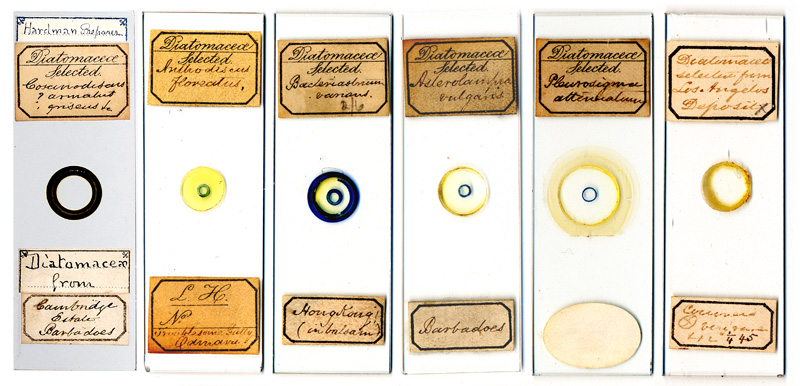
Laurence Hardman 1808 – 1896
Brian Stevenson, Kentucky, USA
Laurence Hardman was a fairly wealthy English merchant who enjoyed microscopy as a hobby. He clearly had both the time and the ambition to investigate the microscopic features of diatoms and produce a large number of high quality microscope slides of his subjects. All of Hardman’s slides of which I am aware consist of arranged diatoms, either a single species or individual specimens of multiple species from a specific location. He seems to have taken to heart George Walker-Arnott’s proclamation that “were he to commence a fresh collection of diatomaceae he would admit none but perfectly pure and unmixed gatherings into his cabinet” (Lang, 1870).
Brian Bracegirdle’s Microscopical Mounts and Mounters illustrates a microscope slide made by Laurence Hardman (plate 20-G, and Figure 1, below). Dr. Bracegirdle described it as, “a slide by Hardman, of whom little is known!”. Fame is fleeting, indeed! In his time, Laurence Hardman was a well-regarded expert on diatoms and a respected maker of high-quality microscope slides. Although Hardman does not appear to have written any publications on diatoms, his good friend Robert Kaye Greville wrote extensively about the many unique diatom species he found in Hardman’s slide cabinet. At least 6 different species of diatom were named after Hardman: Auliscus hardmanianus, Campylodiscus hardmanianus, Hemidiscus hardmanianus, Palmeria hardmaniana, Stictodiscus hardmanianus and Triceratium hardmanianum. In return, Hardman named the diatom Arachnoidiscus grevilleanus after his friend.

Figure 1. Examples of microscope slides prepared by Laurence Hardman. All are of diatoms. The left slide contains a group of one or two species of diatom (Hardman was also uncertain). The four center slides each contain an arrangement of diatoms from a single species. The rightmost slide contains an arrangement of >20 species from the Los Angeles diatom deposit. Photomicrographs of the Asterolampra, Pleurosigma and Los Angeles diatoms are shown below in Figures 5, 6 and 7.
Hardman generally labeled his mounts with light brown labels, often preprinted with ‘Diatomaceae Selected’ in script. However, plain labels are not uncommon (e.g. the far right slide and Figure 3). The slide on the far left was additionally labeled by as-yet unidentified microscopist ‘JR’ as having been prepared by Hardman. I did not find any evidence of Hardman selling slides, so this was probably a gift or an exchange. The slide next to that contains an unusual label preprinted with Hardman’s initials.
Laurence Hardman was born July 23, 1808 in Rochdale, Lancashire, England. His father, also named Laurence, was a tailor and mercer (dealer of fine fabrics). Young Laurence’s 1832 marriage record indicates that he followed his father into that trade. On August 2 of that year, he married Margaret Haworth, also of Rochdale. 1841 found the couple living in Walton on the Hill, Lancashire. The 1851 census records the Hardman’s having a six year-old son, Charles Robert, who was born approximately 1845 in Newcastle. I did not locate any indications of the Hardmans living in Newcastle, which, combined with the gap between the couple’s marriage and Robert’s birth, suggests that he may have been adopted. They do not appear to have had any other children. In 1851, and on every census thereafter, the family lived on Rock Park Road, Higher Bebington, Cheshire. This is adjacent to Rock Ferry Road, and the area is also known as Birkenhead, two addresses often given for Hardman in historical records. His home was across the River Mersey from Liverpool.
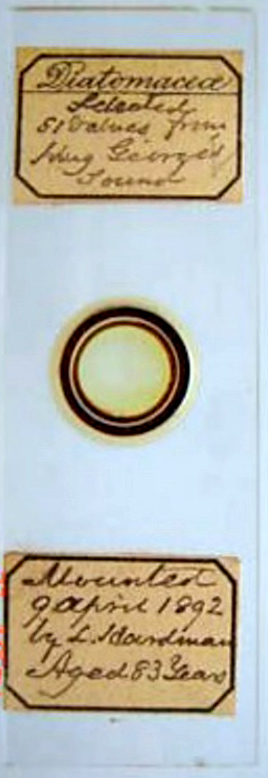
Figure 2. An unusual microscope slide signed and dated by Laurence Hardman on April 9, 1892, when he was 83 years old. This figure is from a screen shot taken when it was auctioned over the internet several years ago. It will be greatly appreciated if the current owner of this slide would be so kind as to send the author a high resolution image.
During the 1830s, Laurence’s business diverted from tailoring to sugar importing and refining, and possibly other businesses. The 1841 census listed to his occupation as “merchant”, and the 1851 census labeled him a “general merchant”. Hardman was issued a patent in 1843 “for certain improvements in machinery or apparatus to be employed in the manufacture of sugar”. More specifically, this was elaborated in Questions and Answers Concerning Sugar as “Lawrence Hardman, who in 1843 invented and patented in England a centrifugal machine, the use of which for the purpose of separating the sugar from the molasses commenced in 1860 and since has become universal wherever either raw or refined sugar is produced”. Robert A. Macfie reported additional details to the Chancery Fund Commission, “The system of refining by employing centrifugal force to expel the syrup from the grains of crystalline sugar had been patented in this country in 1843…my fellow-townsman Mr. Laurence Hardman, to whom belongs the honour of having introduced the application of the hydroextractor and the centrifugal principle into the manufacture of sugar. And I may mention a remarkable circumstance; the operative manager of that gentleman's works in India was experimenting there, on the application of this principle, almost as soon, or about the same time, as Mr. Hardman himself experimented here, neither party having any concert together or exchange of ideas”. Thus, Hardman had an established sugar operation in India by 1843.
Sugar was the topic of letters written by Hardman to government official in 1848, summarized as “lays before the chancellor an anomaly in the scale of duties upon sugars; gives a table which sets out the difference in duties between colonial and foreign sugars; comments that he has already been ruined by the alterations that have been made recently in the sugar duties but hopes that by pointing out the unjustness of the scale he may help colonial refiners; the consequence of this anomalous scale is that Dutch refiners would import just below the standard for refined, and in this way the colonies would be unable to compete”.
Records suggest that Hardman was not actually “ruined” by the sugar duties. He and Margaret appear to have lived fairly well, with all censuses after 1841 indicating both a cook and a housemaid. The 1871 census recorded Laurence as being 62 years old and a “retired East India merchant”, indicating that he did not need to work any more. In those days before social safety nets, men and women usually worked until the day they died. In 1883, and presumably other years, Hardman sat on the Board of Directors of the Wirral Water Works Company, another indication of his wealth and prestige. Income from his business probably provided Laurence with the time and resources necessary to collect, sort and mount his impressive diatom collection.
Hardman was deeply involved with diatom studies by the 1850s. On December 16, 1858, Thomas Comer read a paper to the Historic Society of Lancashire and Cheshire on “the diatomaceae of the neighbourhood of Liverpool”, stating “My best thanks are tendered to three members of the Microscopical Club of this town, Messrs. G. M. Browne, T. Sansom and L. Hardman, who have very greatly assisted me; how much, their initials, attached to the localities given on their authority, will shew”.
During the 1860s, Robert K. Greville presented several reports to The Microscopical Society of London on "new and rare diatoms". These reports relied heavily upon Laurence Hardman’s collection, as the following excerpts demonstrate:
“Palmeria Hardmaniana, n. sp., Grev…The first gatherings of Diatoms in Hongkong Harbour, sent me by Mr. Palmer, contained some imperfect frustules of this Diatom, which, along with his notes and sketches, greatly stimulated my desire for more perfect materials. Fortunately my friend Mr. L. Hardman had also received some collections from the same locality; and, as they were rich in this production, he, at my request, most kindly instituted a careful and minute examination into its structure; and it is only due to his friendly aid and unrivalled manipulation to state that it is mainly from his notes, sketches, and specimens that my drawings and descriptions were prepared. My valued correspondent Mr. Palmer subsequently forwarded a cell filled with frustules, preserved in fluid, along with additional interesting information confirming the results at which both Mr. Hardman and myself had arrived. It is with sincere pleasure that I unite with the name of the discoverer, now so worthily bestowed on the genus, that of the gentleman who so materially aided me in the investigation of its structure” (see Figure 3, below).
“Cresswellia Palmeriana, n. sp., Grev…For the finest example in my own cabinet, I am indebted to the generosity of Lawrence Hardman, Esq., the well-known diatomist and admirable microscopical manipulator, whose friendly assistance in some very critical investigation, I shall hereafter have a more favorable opportunity of acknowledging”.
“Arachnoidiscus Grevilleanus, n. sp., Hardman…Barbadoes deposit, Springfield and Cambridge estates; Laurence Hardman, Esq.; C. Johnson, Esq.; R. K. G.; rare…With regard to the species now under consideration, on which my friend Mr. Hardman has done me the great honour to bestow my name, it differs so essentially from every other so-called species that I cannot hesitate to admit it…It is satisfactory that specimens should have been obtained from different sources: from the deposit of the Springfield estate, by Mr. Hardman; from that of the Cambridge estate, by Mr. Johnson and myself. It appears, however, to be extremely rare. The diameter is upwards of .0050"; but, as in the other species, the size is probably exceedingly variable. A. ornatus is sometimes very small; but I have a disc before me .0200" in diameter, belonging to Mr. Hardman's cabinet”.
“Triceratium zonatulatum, n. sp., Grev…Singapore; obtained from shell-cleanings, by Laurence Hardman, Esq. This, and a number of other interesting species, are preserved in the cabinet of Mr. Laurence Hardman, who has kindly placed in my hands a large number of exquisitely mounted slides for examination”.
“Amphitetras parallela, Ehr…The present diatom satisfactorily illustrates the transition from a four- to a six-angled valve. Both forms occur in slides prepared by Mr. Hardman from Red Sea dredgings”.
“Amphitetras nobilis, n. sp., Grev…In dredgings from the Red Sea; L. Hardman, Esq. A magnificent species, and one of many undescribed novelties contained in my friend Mr. Hardman's cabinet”.
“Mastogonia Actinoptychus, Ehr…As the figure published by Ehrenberg is not quite satisfactory, I have been induced to offer one taken from a fine example in my friend Mr. L. Hardman's cabinet. The station given by Ehrenberg is Virginia. Mr. Hardman obtained his specimens from the celebrated Monterey deposit in California”.
“Heliopelta nitida, n. sp., Grev…Deposit at Los Angeles, California; L. Hardman…To my friend Mr. Laurence Hardman we are indebted for the discovery of what appears to be an unquestionably new species of this fine genus, and individually I have to thank him for enriching my cabinet with a specimen”.
“Gephyria constricta, n. sp,, Grev…Monterey deposit ; L. Hardman, Esq. A noble species, of which, through the kindness of Mr. Hardman, I have seen a number of examples”.

Figure 3. A Hardman preparation of Palmeria hardmaniana and two other species from Hong Kong.
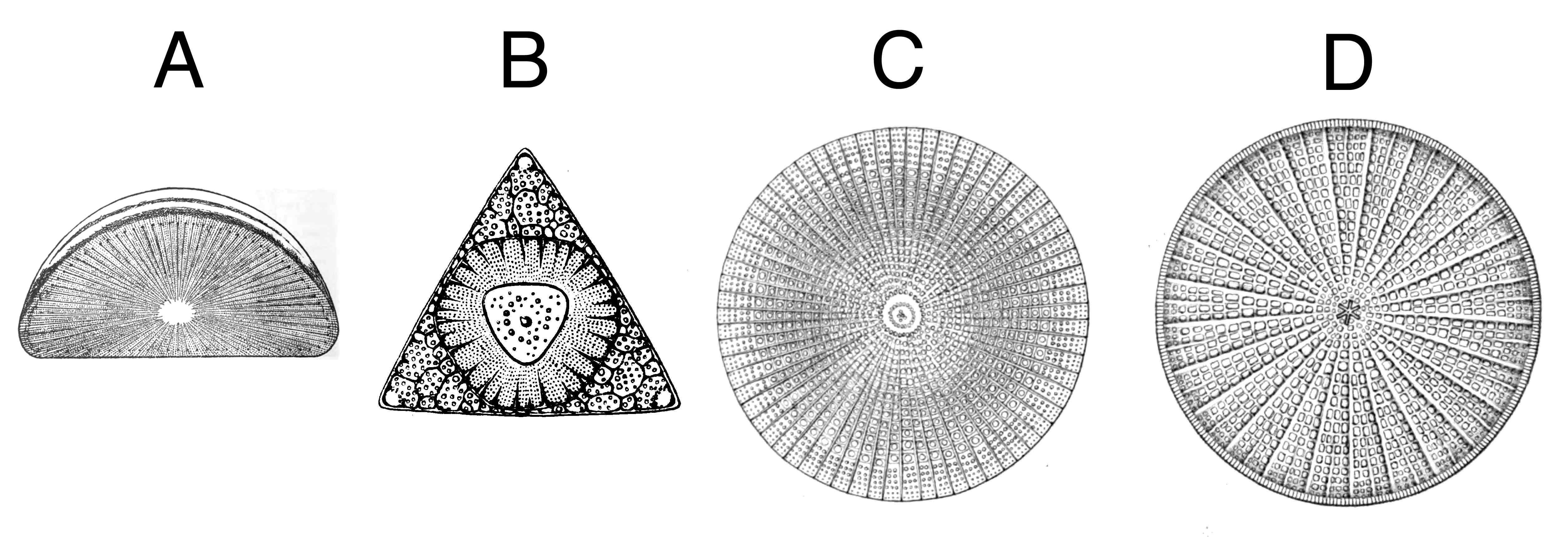
Figure 4. Some diatoms named after or by Laurence Hardman. B, C and D to the same scale, scale of A is not known. (A) Palmeria hardmaniana (drawn by H.F. van Heurck). (B) Triceratium hardmanianum (drawn by R.K. Greville). (C) Stictodiscus hardmanianus (drawn by R.K. Greville). (D) Arachnoidiscus grenvilleanus (drawn by R.K. Greville).
The Rev. William H. Dallinger read a paper “On Navicula crassinervis, Frustulina saxonica and Navicula rhomboides, as Test-objects” to the Royal Microscopical Society in 1877, which included the comment “Rhomboides…some exquisite specimens prepared and mounted by L. Hardman, Esq., were courteously given me by him, and I did my best at that time with them”.
That same year, Arthur Cottam reported to the Quekett Microscopical Club on “A New Aulacodiscus, from the West Coast of Africa”. On distinguishing features of this new diatom from others of the genus, Cottam extensively quoted Hardman’s opinions: “I believe the fact to be as Mr. Hardman describes it in a letter I received from him yesterday. He says ‘The lines of granules I believe invariably bifurcate; indeed, they must of necessity do so if the space between the granules be alike and the granules all of one size-which, I think, you will find they are, except the granules of the primary rays. Although it may be said that granules run obliquely from the primary rays, it will be found that the same granules also radiate from the centre to the margin, bifurcating at different distances, in accordance with the varying forms of the valves…The decussating aspect of the lines of granules depends in great measure on the forms of the valves; if the processes be on a raised or mammate surface the lines will be more curved or arched than when they rise from a flat surface, and in such case the decussation is more striking to the eye’…The chief distinction, as it appears to me, between undoubted specimens of A. Kittoni and the new form is in the processes, which in the first are (as Mr. Hardman describes them) like ‘eye-brows’, and the last are distinct ‘hoods’…the hood is not circular, but like the thick end of a wedge with the corners rounded off, and the point of the wedge, if the sides were produced, would be the centre of the valve or very near it. Mr. Hardman seems to think that the hoods may have been injured, some portion of them destroyed by the strong boiling in acids which was requisite to clean the Algoa Bay guano. And he informs me that he has found two specimens from the Cambridge, Barbadoes deposit, mounted some years ago, which are identical with the Algoa Bay specimens, ‘but the processes are rather more developed, yet much less so than the West Coast of Africa one’."
Hardman collected other natural objects besides diatoms. He may have made slides from some of those objects – if a reader knows of any, please contact the author. During 1876, Hardman made several donations to the Free Public Library, Museum, and Gallery of Art, of the Borough of Liverpool: “A small specimen of the Basket Fish (Astrophyton) from the Falkland Islands; specimens of eight species of Sponge from the West Indies, and one from the Falkland Islands; presented by Mr. Lawrence Hardman”.
During 1875, Thomas Higgin reported to the Liverpool Literary and Philosophical Society on sponges, stating, “A remarkable instance of this similarity of spicule complement with diversity of skeleton form has lately come under my notice, in two sponges given me with some others by Mr. Laurence Hardman, of Rock Ferry”. Higgin later reported, “The twisted stem or glass rope is almost identical with that of Hyalonema Siebolda: the surface of the spicules composing it hardly differs except towards the lower part, where the difference is only sufficient to indicate a variety; while the anchoring head or termination is of the same character— namely, mitre-shaped with four opposite arms. The free ends, however, of these spicules in the Japanese specimens are generally broken off; but an example exists in the Liverpool Free Museum (no. 10. 9. 68. 1) in which many of the terminations remain; and Mr. Laurence Hardman, of Rock Ferry, also has a specimen, received last year through his son from the island of Inosima, in which the free ends are in a tolerably perfect condition”. This last statement suggests that Laurence’s son, Robert, travelled to the Far East, possibly in connection with his father’s Asian sugar business. “Inosima” was probably the Japanese island now known as Enoshima. As an aside, Laurence Hardman was a long-time member of the Liverpool Literary and Philosophical Society, having joined in 1856.
The above records, and others, indicate that Laurence Hardman was not shy about sharing his collection with others. In 1866, he exhibited his microscopical preparations to the Liverpool Chemists’ Association, “This, the ninth conversazione of the Association, was held, as usual, in the Royal Institution, and its several attractive galleries of art, natural history, geology, etc., and also the Museum of the Chemists' Association and of applied science, aided considerably to heighten the enjoyment of the visitors. The weather was anything but alluring, to the ladies especially; still, in very little time after half-past six, a very select company of about 200 ladies and gentlemen assembled, and betook themselves to various rooms and galleries. Microscopic inspection was much patronized; and the wonderful organization and structure of the objects shown under the powerful instruments of Messrs. John Abraham, T. F. Abraham, Laurence Hardman, C. F. Salt, and Joseph Marples, arranged along the geological gallery, merited the favour. The splendid microphotographs of Dr. Maddox, brought within the range of the general public by the ability and enterprise of Mr. James How, of Foster Lane, London, were arranged in the bird-room, and attracted a large number of discerning visitors”. Hardman donated “18 Slides of Diatomaceae” to the Quekett Microscopical Club in January, 1871, and a further 6 slides of diatoms in 1872.
The 1884 Natural History of Commercial Sea Fishes of Great Britain and Ireland, by William Houghton, reported, “I sent a small bottle containing the contents of a pilchard's stomach and intestine to Mr. Laurence Hardman of Birkenhead, a gentleman well versed in the diatomaceae. He has kindly examined these things for me, and has sent the following report: ‘A very large percentage of the diatoms, probably more than 90 per cent., are (1) Coscinodiscus eccentricus and varieties. The next most abundant species is (2) Podosira maculata. These two diatoms have frequently been found in the stomachs of Pectens, from the south of England, especially on the coasts of Sussex, Hants, and Dorset. Following these perhaps the most abundant diatom is (3) Triceratium alternans; next (4) Orthosira marina, this previous to being boiled in acid was in filaments, but now the valves are all separated. All the other forms I have met with beyond these are very sparse, I therefore note them in alphabetical order, without reference to their comparative numbers. (5) Actinocyclus undulatus, (6) A. crassus, (7) Biddulphia aurita, (8) Diatoma elongata, (9) Dictyocha fibula, (10) Grammatophora marina, (11) Pinnularia cyprinus, (12) Navicula ? specimen very small and pandusiform, (13) Pleurosigma angulatum, (14) P. transversale, (15) Rhaphoneis ? species (probably rhombus), (16) Rhizosolemia styliformis, (17) Stauroneis pulchella, (18) Surirella fastuosa, (19) Zygoceros rhombus, (20) Coscinodiscus radiatus, (21) C. lineatus. I should also notice that there are several varieties in what I call Coscinodiscus eccentricus; some might be considered Odontodisci from their spinous margins, and others have marginal or rather sub-marginal processes or tubercles. They may probably belong to the genus Heterostephania (Ehr.), or the genus Perethyra (Ehr.). There may probably be other species besides those enumerated’."
Hardman’s skill in preparing diatom slides was attested to by Thomas C. White, former President of the Quekett Microscopical Club, in his 1887 A Manual of Elementary Microscopical Manipulation for the Use of Amateurs, “The washed and cleaned deposit may be stirred up in a cylindrical glass measure, and dippings of the first sediment examined under the microscope. He will then probably find large grains of sand mixed with the larger specimens of diatoms. Dr. Carpenter recommends that these diatoms should be pushed on one side, by means of a bristle inserted in a wooden handle. If this plan is adopted, great gentleness must be used, as even, with such a comparatively delicate instrument, a rough touch will end in the fracture of the fragile frustule. Professor Redfern suggested the use of split hairs, such as may often be found in an old shaving brush, for this purpose. These do not appear split till they are pressed on the diatom, when they open and grip it like fairy forceps; but even here care must be employed, lest a fracture of the valve ensues. Mr. William Borrer, Junr., devised an ingenious arrangement for picking out, and arranging diatoms, and, which, under his hands, was attended with great success. It may be described as a collar of cork fitting on to the lower end of a low power objective, and through which a needle is thrust obliquely. To the end of the needle, one of the barbed lancets of a bee's sting, or what is even better, the bristle from a rat's tail is cemented. By adjusting the point of this in such a manner as to be in focus at nearly the same time as the diatom, it can be brought down on to it gently, and, as it adheres to the barb, it can be raised and transferred to a clean slide. Some mounters of diatoms acquire an unusual dexterity in cleaning, selecting and mounting these minute frustules, as evidenced by the slides of A. C. Cole and L. Hardman, and the still more marvelous achievements of Herr Möller, but the student will hardly be likely to aspire to the perfection attained by these men, but will generally be content if he can mount diatoms cleanly and suitably for his own satisfaction”.
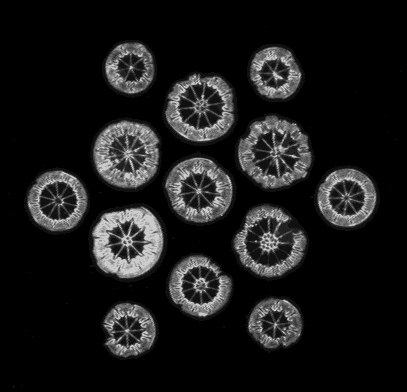
Figure 5. Asterolampra vulgaris, mounted by Laurence Hardman (see Figure 1). Darkfield illumination.
Julien Deby purchased 1444 slides from Hardman in 1889. Deby wrote ,”Hardman L. - His whole Collection, the work of a quarter of a century, containing from 25,000 to 30,000 picked and selected Diatoms from all the most celebrated deposits and localities in the world. Most of Greville's rarest species are found here, as well as the gems from many rare gatherings. This collection was purchased by Julien Deby in 1889. - A MS. alphabetical as well as a serial Catalogue of the contained species, prepared by Mr. Hardman, accompanies these slides”. The British Museum obtained the Hardman collection in 1893: “Hardman (LAWRANCE). His entire collection of nearly 30,000 select diatoms, typical of all the most celebrated deposits, and mounted on 1,444 slides, purchased as part of Deby's collection in 1893”. Hardman undoubtedly produced many slides besides those purchased by Deby, as demonstrated by the JR-labeled slide shown in Figure 1 and the slide dated 1892 shown in Figure 2.
Laurence’s wife, Margaret, died in 1894, at the age of 83. Laurence died in 1896, age 87. The Proceedings of the Liverpool Literary and Philosophical Society briefly noted his passing, “The Council have to record the loss the Society sustained during the last Session in the deaths of Mr. William Andrews Unwin and Mr. Lawrence Hardman. The Society, by resolution, expressed its great regret upon the loss of these old and valued members”.
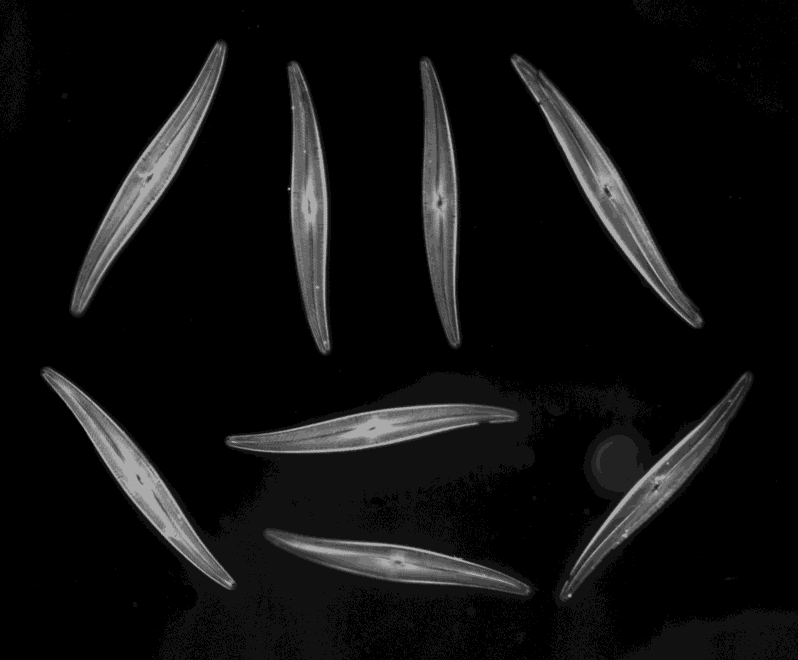
Figure 6. Photomicrograph of Pleurosigma attenuatum, mounted by Laurence Hardman (see Figure 1). Darkfield illumination.
Diatom species named after Laurence Hardman:
(from algaebase: http://www.algaebase.org)
|
Auliscus hardmanianus Class Mediophyceae Subclass Biddulphiophycidae Order Triceratiales Family Triceratiaceae |
Campylodiscus hardmanianus Class Bacillariophyceae Subclass Bacillariophycidae Order Surirellales Family Surirellaceae |
Hemidiscus hardmanianus Class Coscinodiscophyceae Subclass Coscinodiscophycidae Order Coscinodiscales Family Hemidiscaceae |
|
Palmeria hardmaniana Class Coscinodiscophyceae Subclass Coscinodiscophycidae Order Coscinodiscales Family Coscinodiscaceae |
Stictodiscus hardmanianus Class Coscinodiscophyceae Subclass Coscinodiscophycidae Order Stictodiscales Family Stictodiscaceae |
Triceratium hardmanianum Class Mediophyceae Subclass Biddulphiophycidae Order Triceratiales Family Triceratiaceae |
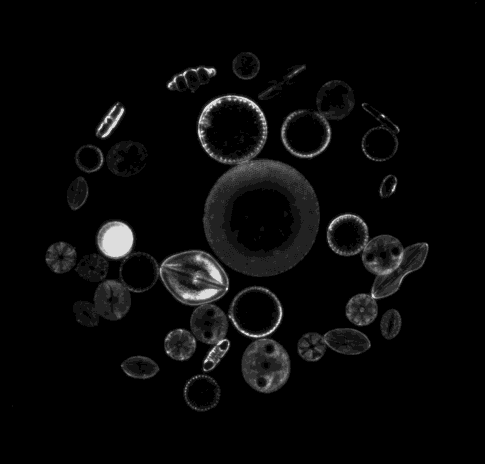
Comments to the author will be welcomed.
Twenty-third Annual Report of the Committee of the Free Public Library, Museum, and Gallery of Art, of the Borough of Liverpool (1876) page 13
Bagshaw, Samuel (1850) History, Gazetteer, and Directory of the County Palatine of Chester, Wirrall Hundred, Bebbington, Rock Ferry and Rock Park, pages 693-694
Catalogue of the Papers of Lord [William] George Cavendish Bentinck (1802-1848), http://www.nottingham.ac.uk/manuscripts/collections/online-mss-catalogues/cats/port_lordgeorge.html, letters Pw L 165 2.8.1848 and Pw L 166 2.8.1848
Comer, Thomas (1859) Transactions of the Historic Society of Lancashire and Cheshire, vol 11, pages 71-82
Cottam, Arthur (1877) On A New Aulacodiscus, From The West Coast Of Africa, Journal of the Quekett Microscopical Club, Vol. 4, pages 149-153
Dallinger, Rev. William H. (1877) On Navicula crassinervis, Frustulina saxonica and Navicula rhomboides, as Test-objects, Monthly Microscopical Journal, Vol. 17, pages 1-7
Deby, Julien (1891) Bibliotheca Diatomologica seu Catalogus Librorum et Collectionum Exsiccatarum Bacillarieas Quascumque Sistentium, Typis Seminarii, page cxxvii
English vital records, accessed through ancestry.co.uk
Greville, Robert K. (1865) Descriptions of new and rare diatoms. series XIV, Quarterly Journal of Microscopical Science, Vol. 5, pages 1-10
Greville, Robert K. (1865) Descriptions of new and rare diatoms. series XVI, Quarterly Journal of Microscopical Science, Vol. 5, pages 43-57
Greville, Robert K. (1865) Descriptions of new and rare diatoms. series XVII, Quarterly Journal of Microscopical Science, Vol. 5, pages 97-105
Greville, Robert K. (1866) Descriptions of new and rare diatoms. series XVIII, Quarterly Journal of Microscopical Science, Vol. 6, pages 1-9
Greville, Robert K. (1866) Descriptions of new and rare diatoms. series XX (sic, actually number 19), Quarterly Journal of Microscopical Science, Vol. 6, pages 77-86
Greville, Robert K. (1866) Descriptions of new and rare diatoms. series XX, Quarterly Journal of Microscopical Science, Vol. 6, pages 121-130
Greville, Robert K. (1865) Descriptions of new genera and species of diatoms from Hongkong, The Annals and Magazine of Natural History, Third series, no 91, July, pages 1-7
Higgin, Thomas (1875) Sponges, their anatomy, physiology, and classification, Proceedings of the Liverpool Literary and Philosophical Society, Vol. 29, pages 193-216
Houghton, William (1884) The Natural History of Commercial Sea Fishes of Great Britain and Ireland, W Clowes & Sons, Ltd., London, page 386
Journal of the Quekett Microscopical Club (1871) Donations, Vol. 2, page 180
Journal of the Quekett Microscopical Club (1872) Catalogue of microscopical preparations, Vol. 3
Lang, Frederick H. (1870) On selecting and mounting diatoms”, reprinted in English Mechanic and World of Science, vol. 12, pages 270-271.
Pharmaceutical Journal (1866), Liverpool Chemists’ Association Conversazione, Second series, Vol. 7, page 566
Proceedings of the Literary and Philosophical Society of Liverpool (1874) Members list, 63rd session, 1873-74, number 28, page xii
Proceedings of the Liverpool Literary and Philosphical Society (1896), vol 51, page xxix.
Reports from Commissioners, 4 February - 29 July (1864), vol 14, page 119
Skinner, Thomas (1883) Wirral Water Works Company, The Stock Exchange Year-Book for 1883, Casell, Petter, Galpin & Co., London, page 252.
White, Thomas C. (1887) A Manual of Elementary Microscopical Manipulation for the Use of Amateurs, Roper & Drowley, London, pages 69-70.
Microscopy UK Front
Page
Micscape
Magazine
Article
Library
Published in the December 2010 edition of Micscape Magazine.
Please report any Web problems or offer general comments to the Micscape Editor .
Micscape is the on-line monthly magazine of the Microscopy UK website at Microscopy-UK .
© Onview.net Ltd, Microscopy-UK, and all contributors 1995 onwards. All rights reserved. Main site is at www.microscopy-uk.org.uk .